|
Seagrasses, until
recently, had earned only an obscure place in marine aquaria
as occasional, short lived accents in full blown reef tanks
or as nutrient export plants in refugiums. With a little attention
to their needs, however, it is possible to grow and maintain
beautiful stands of seagrasses as the focus of a marine planted
or lagoon style aquarium. This article attempts to assemble
information on seagrass husbandry to serve as a guide for
interested aquarists to set up seagrass dominated systems.
It also briefly covers the natural ecology of seagrass beds
and the current state of this natural resource. Much of the
information represents results and observations from several
projects, experiments and versions of tank design I have attempted
over the last few years in which I have focused on marine
plants.
The term "seagrass" is actually somewhat ambiguous,
and hobbyists sometimes apply it to anything green from the
ocean. Seagrasses are not a true species of grass (which are
in the family Poaceae), and the common name reflects only
their similar appearance to land grasses with long, strap-shaped
leaves. Further confusion is sometimes added when aquarists
refer to "seaweeds" or "marine plants,"
both of which serve as a catchall phrase for seagrass and
macroalgae. As with other aquaria inhabitants, it usually
is best to avoid these muddy terms by referring to the plants
by their Latin species names.
Seagrasses are a diverse group of true vascular angiosperms
(or flowering plants). They are distinct from the red, green
and brown macroalgae species by the presence of vascular tissue,
true roots, underwater flowers and submarine pollination of
those flowers. Currently, taxonomists recognize approximately
60 species of seagrass, though this number is debated, as
is their placement in the taxonomy. Most biologists recognize
four major families of seagrasses: the Zosteraceae, including
Zostera and Phyllospadix genera; the Hydrocharitaceae,
notably with Thalassia and Halophila; the Cymodoceae,
encompassing the familiar Halodule and Syringodium;
and the Posidoniaceae, which hosts only Posidonia genus
plants.1,2,3 Additionally
a fifth family, Ruppiaceae is sometimes accepted as a family
of seagrass, though they are typically more common to brackish
water. Ruppia species are, however, very important
as seagrass in parts of the Mediterranean region, particularly
in the Black, Aral and Caspian Seas.2,3
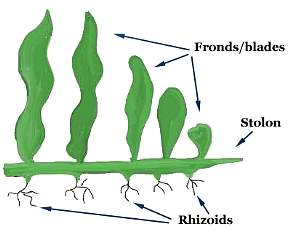 |
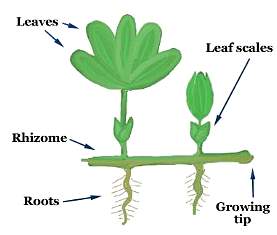 |
|
Seagrass and macroalgae share similar morphology but
have different names for the similar structures. Shown
here are Caulerpa prolifera (left) as
a macroalgae example and Halophila engelmanni
(right) as a seagrass example. Drawings: Sarah
Lardizabal.
|
The Hydrocharitaceae is unique among the four families as
it hosts genera of freshwater, brackish and marine aquatic
plants. This placement in the taxonomy hints at seagrasses'
evolutionary development and at their relationships to freshwater
plants such as water lilies and lotuses. Flowering plants
are the most recent major addition to the plant fossil record,
and seagrasses are some of the younger forms of angiosperms,
evolving approximately 100 million years ago.4
Flowering plants can be found in a nearly limitless array
of forms and in many different habitats, including lines of
plants that have recolonized the water. Seagrasses as a group
represent several evolutionary lines of flowering plants returning
to the oceanic biome.5
These plants are found in nearly every temperate and tropical
shallow coastal environment in the world. Each ocean and continent
hosts its own diverse population of seagrasses though the
diversity is highest in the tropical waters of Papua New Guinea,
the Philippines and India.2
Many genera have pandemic
distribution, and this is particularly true of species within
the Halophila genus such as H. decipiens (paddle
grass). Other species within this same genus are highly endemic
and have their distribution limited to a few hundred square
miles, such as southeastern Florida's Halophila johnsonii
(Johnson's seagrass) or Hawaii's Halophila hawaiiensis.
The Zostera genus is also widespread through temperate
waters along North America's east and west coasts, parts of
Africa's Atlantic and Red Sea coasts, the British Isles and
France, as well as populations spanning the Pacific in Japan
and Vietnam.2 The Zostera
genus is also widespread through temperate waters with species
occurring along North America's east and west coasts, parts
of South Africa and southern Australia, the British Isles,
France, and Chile, as well as populations crossing the Pacific
in Japan.2
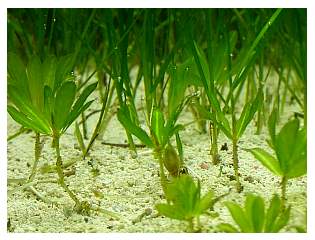 |
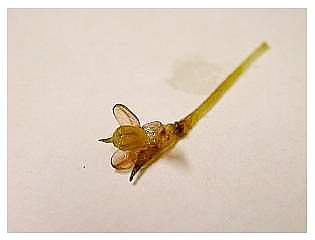 |
|
Seagrass flowers are pollinated underwater. The female
flower in stargrass is a green spike with three white
pistils. The male flower starts as a red sphere in the
center of a pseudowhorl of green leaves and pops open,
setting pollen into the water, to reveal the structure
shown at right. Photos: Sarah Lardizabal.
|
Of the 60 seagrasses, four currently available forms are
suitable for use in tropical marine aquaria. All four hail
from the Caribbean basin. It is likely they appear in the
trade because they can survive the short transit times from
collector to the local shops here in the U.S. They are: turtle
grass - Thalassia testudinum, manatee grass - Syringodium
filiforme, shoal grass - Halodule wrightii and
star grass - Halophila engelmannii. Two baygrasses,
Ruppia maritima and Vallisneria americana (tape
grass), are also found in the hobby, but are most suited to
brackish water aquaria whose salinity does not exceed 20ppt.
Likewise, eelgrass - Zostera marina, is an unusual
find among hobbyist sustained systems as it is a candidate
only for temperate aquaria not exceeding an average of 68°F
(20°C).
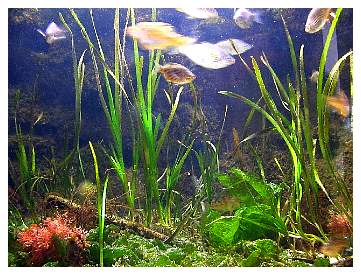 |
|
This lovely Monterey Bay Aquarium (MBA) display features
eelgrass (Zostera) and several macroalgae species
including an unknown Rhodophyta and Ulva lactuca.
Fish include bay pipefish, dwarf perch and shiner perch.
Photo: Sarah Lardizabal.
|
|
Phyllospadix sp. are a small group of seagrasses
calling the northern Pacific home. Like eelgrass, they
are candidates only for coldwater aquaria and reach
considerable height. Their common name is surfgrass.
Pictured here at MBA, CA, USA. Photo: Sarah Lardizabal.
|
New species from other regions are bound to find their way
into the U.S. marine hobby once source material can be imported
and the plants are aquacultured. Collection permits vary considerably
by national and local governments, and it is prudent to thoroughly
research the topic before attempting to collect any species.
Typically, phytosanitary certificates must be obtained to
send plant life, including seagrasses, across national borders.
There are two species of seagrass that are very unlikely to
become a part of the aquarium trade, Halophila johnsonii
(Johnson's seagrass) and Phyllospadix serrulatus, a
member of the surf grass genus. Halophila johnsonii
has been included since 1998 by the U.S. Fish and Wildlife
Service on the federal threatened list under the provisions
of the Endangered Species Act (1973).6,7
Ultimately, our desire for new species must be tempered by
the need to respect and protect this natural resource.
The Seagrass Habitat
Relative to coral
reefs with which we are most familiar, seagrasses inhabit
high nutrient, clear to fairly turbid water in areas of soft
sand and mud substrates. Aquarists who have had the pleasure
of roaming marshes, estuaries and seagrass beds are sure to
recall the characteristic fragrance of such substrates. Besides
often being anoxic within the first few millimeters, these
soils often release hydrogen sulfide when disturbed. Seagrasses
can be found within bays, lagoons, and estuaries as well as
offshore and within yards of patch reefs in coastal areas.
Seagrass beds can consist of single species stands that stretch
for hundreds of yards or they can exist as patchy multi-species
beds covering only a few hundred square feet of bottom. There
are shallow water long lived beds of seagrasses that tend
to exist for decades, if not centuries, and there are deep
water ephemeral beds of seagrasses out on the coastal shelf
that exist for only a few months of the year.
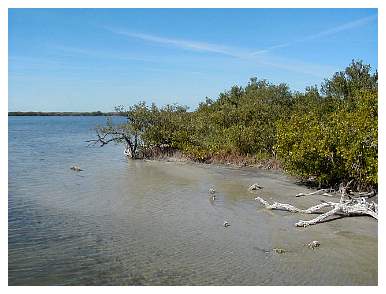 |
Above water, seagrass beds in the wild show up as dark
areas within bays and lagoons, often just a few yards
from mangrove, Rhizophora mangle, stands. Photo
in Indian
River Lagoon, Fort Peirce, FL. Photo: Sarah
Lardizabal.
|
Substrate fauna is diverse and includes annelids, polychaete
worms, bivalves such as oysters and scallops and burrowing
snails. Even the seagrass leaves create a microhabitat that
supports an amazing array of life including encrusting bryozoans,
sponges, epiphytic macroalgae and micro-algae, mussels and
other fauna. One study reported, after combining surveys from
several regions, that there are 450 species of epiphytic algal
that coat seagrass blades, and that's just the algae!8
|
Juvenile lemon sharks, Negaprion brevirostris,
are common in flooded mangrove forests and patrol
the periphery of seagrass beds, as seen here,
waiting for potential prey. Photo: Sarah Lardizabal,
Warderick Wells, Exuma, Bahamas.
|
|
A large number of reef-associated species
also inhabit seagrass beds and other shallow coastal habitats
such as oyster reefs and mangrove swamps during their juvenile
stages. Some representative species from around the world
that inhabit grass beds during this phase include trumpetfish
(Aulostomids), goatfishes, rabbitfishes, a number of wrasses
and parrotfish, as well as game fish including grunts, snappers,
grouper, drums and spadefish. Year-round and lifelong residents
vary by region and include, as a limited sampling, urchins
hosting cardinal fish (such as Banggai cardinals), sea anemones
and their resident clownfishes in the Pacific, pipefishes,
ghostpipefishes, seahorses, sheepshead minnows, sargeant majors
(Abudefduf sp.) and similar Chromis and Dascyllus
sp. fishes. In more temperate areas sheepshead minnows, Fundulus
killifish, grass shrimp (Palaemonetes sp.) and the
economically important Callinectes sapidus (blue crab)
are common. Nassarius sp. snails, whelk, Strombus
sp. conchs and a multitude of other invertebrates are also
found within seagrasses in the western Atlantic. Predators
such as nurse sharks, juvenile lemon sharks, juvenile moray
eels and groupers, stingrays and barracuda often patrol the
edges of seagrass beds searching for prey among the sandflat
infauna. Great barracuda often chase shoals of prey toward
the shore through the beds. The particular species diversity
associated with a seagrass bed depends heavily upon where
in the world it is located. Just as fish and corals are not
the same from a Caribbean to an Indopacific reef, seagrasses
and their associated species change as we move through oceans,
zones and seas.
Several families of fishes and invertebrates
not only live within the meadows of seagrass but also
consume the plants themselves. Urchins, abalones and
angelfish have been known to visit seagrass beds for plant
buffets. In reef aquaria the popular rabbitfishes, surgeonfishes
(excluding the bristletooth tangs such as the Kole and Chevron
- Ctenochaetus sp.) and many angelfishes (in particular
the larger Caribbean grays and French, Pomacanthus arcuata
and P. paru) also occasionally graze on seagrasses.
In addition to these fish and invertebrate browsers there
are mammalian and reptilian foragers of seagrass. Worldwide,
manatees, sea cows and dugongs (Trichechus, Dugong
and Hydrodamalis sp.) are known to consume mostly seagrass
in their diets. Sea turtles, such as the Caribbean native
green (Chelonia mydas) and loggerhead (Caretta caretta),
also are prime examples of seagrass consumers in the wild.
In terms of coral populations, both hard and soft corals
are found in this environment and, like the fish, vary by
the seagrass bed's location. These include but are not limited
to: star corals - Montastraea, brain coral - Diploria
labryinthiformis, fire coral - Millepora alcicornis,
Gorgonia, Fungia, Porites, Heliopora,
Sarcophyton, Sinularia and Nehpthea.
Cnidarians such as tube anemones, flower anemones and even
Cassiopeia jellyfish may be appropriate, though require
more specialized tanks. It should be mentioned that, in the
wild, most corals would be found within a climax
species dominated bed, such as near Thalassia in the
Caribbean.
Seagrasses are also crucial habitat for
a number of threatened, vulnerable or endangered species including
the aforementioned green sea turtles, manatees, dugongs and
sea cows. The entire seahorse genus Hippocampus is
listed by IUCN6 and several
species inhabit seagrass beds through their life cycle in
several regions. Seagrass meadows also serve as nursery and
breeding grounds for three listed species of grouper: the
gag (Mycteroperca microlepsis), Venezuelan (Mycteroperca
cidi) and the endangered Nassau (Epinephelus striatus).
The Status of Seagrasses
Like coral reefs, seagrasses are a
valuable natural resource that are under direct and indirect
human impacts that have led to their decline in several areas
of the world. Increasing coastal populations contribute to
pollution of seagrass habitat via nutrient-laden runoff. Freshwater
drainage of wetlands and rivers can also contribute overly
rich water to seagrass beds. An imbalance of nutrients typically
drives algal blooms that smother seagrasses either by overgrowth
of the leaves or by limiting the amount of light reaching
the plants. While these marine plants thrive in nutrient rich
areas, the wrong mix of nutrients can be lethal if conditions
persist long enough. Direct human impacts are seen in areas
where seagrass beds are dredged for piers, channels and other
coastal development.2 Additionally,
localized seagrass death can occur where anchors are dropped.
Unaware or careless marine vessel operators contribute to
the decline of intact beds by propeller scarring, carving
deep white scars into the beds that can be seen from aerial
vantage points.
In the U.S., Florida's seagrasses show some of the largest
declines, particularly in Tampa Bay, which lost over 80% of
seagrass coverage from 1879 to 1981.2,9
Disease has played a major role in the decline of the beds
due to a slime mold, Labyrinthula sp. in these areas,
particularly in the Chesapeake and north Atlantic in the 1930s.2,10,11
There are signs that the loss of seagrass habitat can be reversed
with good management and through bed restoration activities.
Over the last twenty years Chesapeake beds have made a recovery,
increasing over 30% throughout the Bay.2
In Tampa Bay the seagrass had recovered to 35% of historic
levels by 1997 and current survey projects continue to show
progress in its recovery.12
The decline of grass beds is extremely costly to our economy
in the U.S. and in the world. The beds stabilize sediment
and help to maintain high water quality by filtering out nutrients
from terrestrial inputs, trapping sediment, recycling nutrients
within the ecosystem, and sequestering carbon.2
They also serve as enormous nurseries for hundreds of species
of commercially important fish and crustaceans. In Monroe
County, Florida the value of five commercial fisheries based
on species that depend on seagrasses in their lifecycle is
estimated to be $48.7 million annually.2
This figure does not include revenue from industries such
as ecotourism that are also indirectly associated with the
area's seagrass beds. In fact, the global value of all known
seagrass and algal beds for their single role of "nutrient
cycling" is estimated at $3.8 trillion each year.2
Add to this the associated value of global commercial fisheries
support, ecotourism and coastline protection, and we begin
to grasp just what we stand to lose if seagrass beds disappear.
Seagrass Species
Presented here are the profiles of
four species of seagrass that are available to marine aquarists
today. Since they are all from the Caribbean basin they share
similar ranges including the east coast of the U.S. in Florida
starting at Cape Canaveral, along the Gulf of Mexico coasts
from Florida to Texas and along the full stretch of Mexico's
coasts to the Yucatan. They are also found distributed along
the coasts and near the reefs of several Caribbean countries
including Bermuda, the Bahamas, Puerto Rico and Cuba. In deeper
water a few species can be patchily distributed between larger
islands. Most of the seagrasses are usually found within the
protected lagoons created by barrier islands within the Gulf
and along Florida's Atlantic coast. Around the island countries
and in the Florida Keys the seagrasses stretch out immediately
from shore onto the coastal shelf and extend seaward.
Turtle grass - Thalassia testudinum
According to most taxonomists Thalassia belongs to
the Hydrochartiaceae family and is a genus containing species
across several different continents. The most often seen species
is the Caribbean and Western tropical Atlantic T. testudinum,
or turtle grass. As the name suggests this species is a popular
item in the diet of sea turtles. Turtle grass is a climax
species in a seagrass bed, typical of areas that have long
supported seagrass and other aquatic life. They are relatively
large plants with strap-shaped leaves that grow 10-16"
in length and have varying leaf widths ranging from a slim
¼" to ¾" across. Collected fragments
of these plants tend to come from outside the U.S. and into
the trade via private small sales.
Thalassia is the only seagrass species I have attempted
to culture that can be transplanted as a single plant without
an attached rhizome. This species has a very large root system
that can extend well beyond the 6" DSB
often recommended for these plants. Turtle grass is common
in shallow water as little as 3' deep and often extends down
to 30 - 40' in coastal areas where they form extensive monospecific
underwater meadows measuring several football fields in length.2
Turtle grass grows well only in areas of consistently high
salinity (28 ppt and higher) and is usually found at the inlets
of lagoons and bays. They can also be found farther out on
the shelf near coral heads and between spur and groove reefs
where water quality allows light to reach the plants on the
seafloor.
Manatee grass - Syringodium filiforme
The Syringodium genus belongs to the Cymodoceae family
and is also a subtropical to tropical zone seagrass genera.
Syringodium filiforme is the most common seagrass found
in the hobby, and is found naturally as small populations
within larger turtle grass beds or at the periphery of turtle
grass beds. It is also found mixed in with Halodule wrightii
in shallow areas from 5 - 20' in depth. Manatee grass, like
turtle grass, gains its name from one of its consumers, the
manatee in the Caribbean. Like other species of seagrass,
floating disturbed fragments of these plants continually wash
ashore on the lagoonal beaches and mangrove swamps close to
submerged beds. Manatee grass can grow to considerable heights
in tall aquaria, up to 24", and produce thin (1 - 2mm)
tubular positively-buoyant leaves. In shorter tanks the leaves
tend to break off at the water line. This does not seem to
be detrimental, so far, to the few plants of this species
that I currently culture.
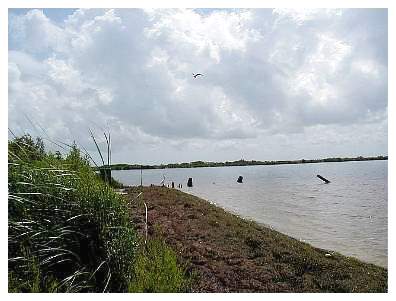 |
Colonies of seagrasses are routine finds in beached
seawrack due to foraging activity by manatees, turtles
and wave action. During days of high wind, or following
extreme storms and hurricanes, seagrass can cover entire
lagoon beaches as seen above with the green-brown rolls
of 'grasses next to the marsh plants. Photo: Sarah Lardizabal
in IRL,
Titusville, FL.
|
Manatee grass is often hard to distinguish from shoal grass,
but their tubular leaves, appearing circular in cross-section,
distinguish it from the flattened leaves of shoal grass. The
two species can also be distinguished if you have reproducing
populations of both. Manatee grass produces new plants by
extending the rhizome under the surface and pushing daughter
plants through the substrate whereas shoal grass produces
new plants and rhizome material in the water column and anchors
them by roots which tap into the substrate and drag the new
plant down.
Shoal grass - Halodule wrightii
The Halodule genus is another temperate to tropical
zone genera belonging to the Cymodoceae family and includes
several Caribbean natives as well as species in many other
oceans. Halodule wrightii is the dominant species of
the Halodules and has the largest range of the four
seagrasses in the trade. Including the range mentioned through
the Gulf of Mexico and Florida's coasts, this species pushes
north along the U.S. all the way to North Carolina where it
shares turf with Zostera marina.2
This species is typically the first to colonize disturbed
seagrass beds and propeller scarred areas, and grows prolifically
just a few feet below the low tide line in very shallow water
as little as 6" deep and can extend out to the edges
of deeper manatee and turtle grass dominated beds in several
feet of water. There is a small complex of closely-related
species spread out across the Caribbean, but H. wrightii
does not currently belong to this taxonomic grouping.2
Halodule wrightii is currently the most common Halodule
species in the trade and is, like manatee grass, typically
available from Florida collectors.
This plant exhibits very thin, 1mm wide leaves that are flat
and grow from 3 - 14" in height, though 6-8" is
far more common. Interestingly, this species and manatee grass
both respond to increasing water flow velocities by growing
taller and faster. Shoal grass roots penetrate an average
of four inches into the substrate and are much shorter than
those of turtle or manatee grass. It also takes far less time
to recover from transplant shock and, in good conditions,
should be sprouting new plants in aquaria inside of two weeks.
Star grass - Halophila engelmannii
The Halophilas are a very diverse group of small seagrasses
that display shapes and growth patterns very different from
typical seagrasses. They are a tropical species and belong
to the Hydrocharitaceae alongside Thalassia and Enhalus
genera. As a group they are very small in size in comparison
to the other seagrasses and range from a diminutive 0.5 to
4". Their leaves are also quite different and vary by
species from a basic oval leaf shape to elongated pinnate
forms. Leaves can be arranged into various patterns, as pairs,
palm-tree-like pseudowhorls,
fern-like presentations and in more basic groups of three
or four.
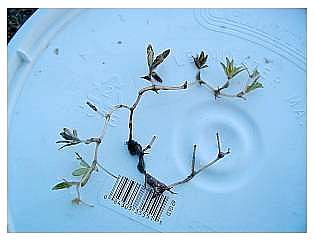 |
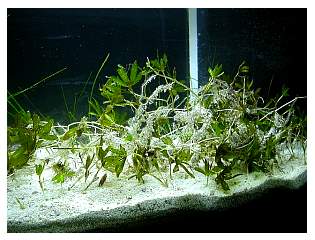 |
|
Wrack collected colonies of seagrass, such as H.
engelmanni in the left photo, tend to have
very little preserved root structure and are typically
in a stage of decay. Wild harvested colonies of seagrass
typically have a fifty/fifty chance of survival. Aquacultured
seagrasses, right, show vibrant color, good root
growth with substrate attached via root hairs, large
leaf sets and are healthier overall. Transplanting success
nears 95% with careful handling. Photos: Sarah Lardizabal.
|
Several species are from the Caribbean but only one, H.
engelmannii, has so far made it into culture and from
there into the trade via a small group of hobbyists. Star
grass, so named for its delightful arrangement of 6-8 leaves
in a pseudowhorl around the plant's stem, is a small (1-3"
tall) plant with a tenacious growth rate in aquaria. This
species, like another Caribbean native, H. decipiens
(paddle grass) is reported to occur in deeper water farther
out on the coastal shelf around Florida up to 60'.2
However, I have found small populations of this seagrass growing
alongside manatee and shoal grasses in much shallower water
from 5-10'. In aquaria it grows well in a range of light (90
- 280 micromoles/m2/sec)
and salinity (20 - 36 ppt) regimes and is quite unaffected
by temperature, happily growing in 65 - 85°F aquaria.
When aquaria temperatures rise a few degrees from cool periods
(generally above 72°F) the plants are stimulated to produce
female flowers. Male flowers have only been produced in one
event in my aquaria, following the start of a dinoflagellate
bloom that ultimately smothered the star grass.
When conditions are optimal this species, like shoal grass,
grows quickly enough to be considered weedy in aquaria. Over
500 plants were produced in one six-week period from an initial
eighteen plants in one particular system. With growth rates
like this fragments can be harvested from the parent frequently
without the need to produce and germinate seeds and seedlings
for the trade. Since this species is the least demanding of
the four available, I predict it will also soon be the most
common of the four within the trade.
Tank Husbandry
The idea to setup seagrass dedicated
aquaria has gained a bit of momentum in the past two years,
particularly following the recent publication of Julian Sprung's13
and Steven Pro's14 articles
touching on seagrass aquariums. Anthony Calfo15
has also penned an article concerning these plants, and hints
from Eric Borneman can be found in a few places on the web.
Many questions, however, remain unanswered as this relatively
new aspect of our hobby grows.
There are many ways to integrate seagrasses into aquariums,
but there are two general categories for seagrass tanks: 1)
lagoon style setups where seagrasses are included as small
percentages of the total biomass, and 2) setups where seagrasses
(and sometimes macroalgae) are kept as the system's dominant
biomass, called seagrass dominated or marine planted aquariums.
In both systems the physical aspects of the tank design -
particularly light and substrate requirements - are the most
important. The approach that best fits an individual aquarist
depends solely on the goals for the display in question. In
lagoon style tanks the emphasis is on corals, and the seagrass
is more or less a "highlighting" species. Since
the biomass of plants is small, their nutrient demands tend
to be low and are easily met by organic sources of nutrients
within the tank (which we will cover shortly). There are already
examples of systems such as this among Reef Central members
(Link
1, 2,
3).
Seagrass dominated aquaria attempt to grow large stands of
seagrasses and macroalgae and tend to have high nutrient demands
that cannot always be met by organic sources alone. For some
of these systems, inorganic sources of nutrients are dosed
similar to what is already done in freshwater aquaria to maximize
the plants' growth. Nutrient dosing in marine aquariums is
admittedly atypical, and is covered briefly below as a preliminary
guide for aquarists who are interested in marine planted tanks.
Light
As photosynthetic autotrophs, seagrasses
require relatively high amounts of light when compared to
marine macroalga. Seagrasses use light in the photosynthetic
active radiation (PAR) range of 400 - 700 nm, which encompasses
light of several colors (red, orange, yellow, green, blue
and violet) that humans see together as white light. The scientific
literature typically reports minimum light requirements for
seagrasses as the percentage of surface irradiation that reaches
the plants after it travels through the water column. Most
seagrasses require light levels at 10 - 30% of surface irradiation
for survival, though Halophila, as a deep-water genus,
can survive at just 5%.16
As aquarists we are much more familiar with the photosynthetic
photon flux density (PPFD) measurements of PAR, in units of
micromoles/m2/second. (See
Sanjay Joshi references.)
However, we can convert from surface irradiation to PPFD by
using the widely noted measurement of 2000 PPFD for noon surface
irradiation in the tropics during the summer. Applying this,
the majority of seagrasses require 200 to 600 micromoles/m2/sec
of light and the Halophila genus requires 100 micromoles/m2/sec.
I have found that these measurements of light requirements
from wild seagrass beds also hold true for aquaria cultured
star, shoal and manatee grass. Halophila engelmannii
has grown well in aquaria with 90, 150 and 280 micromoles/m2/sec.
Halodule wrightii and Syringodium filiforme
did not grow in 90, only slowly in 150 and had very good growth
in 280 micromoles/m2/sec. Thalassia testudinum probably
fits into the higher range of required light levels as it
reportedly does best under very intense illumination (Bill
Chamberlain, pers comm). My Thalassia have not shown
any remarkable growth in the highest light regimes I have
so far attempted, though light may not be the only contributing
factor.
Fluorescent power compact technology is typically sufficient
to generate enough PAR for seagrasses in aquaria that will
have 10 - 14" distances between the light source and
the top of the DSB. For tall tanks or for other situations
where the distance will be increased, very high output (VHO)
fluorescents, the new high output T5s or metal halide bulbs
may be required. The use of daylight spectra bulbs in 5,000
to 10,000K color temperatures will generally maximize the
amount of PAR produced per watt from your lighting. Lower
temperature bulbs, such as the widely available 6500 or 6700K
bulbs, work very well and can be supplemented with a little
actinic lighting to offset the yellowish tones if desired.
Photoperiod length does not seem to be critical for seagrass.
While photoperiod changes naturally throughout the course
of the year, the seasonal changes in seagrass productivity
and sexual reproduction events have been linked to temperature
influences over photoperiod.17
I have used 14:10, 10:14 and 16:8 light: dark photoperiods
with good success and without noting any major changes to
growth rate or flower production.
Temperature
The four species typically available
- shoal, manatee, turtle and star - enjoy subtropical to tropical
water temperatures ranging from 60 - 85°F and do well
in the common range of 75 - 80° F in aquaria. In localized
areas under the right conditions, temperatures in the shallows
can push even higher, particularly during the summer. For
shoal grass colonies in the northern extreme of their range
in North Carolina, lower temperatures are tolerated and the
plants coexist with eelgrass. Seasonal cycles in seagrass
are evident with the plants dying back during cool periods
and growing vigorously as the water warms.
|
Seasonal cycles are apparent in many species of seagrass.
Shown here, in the exact same location, is a bed of
Halodule wrightii from early March (left)
to late July (right) within the Indian River
Lagoon (IRL), Titusville, FL.
Photos: Sarah Lardizabal.
|
Substrate
As mentioned, seagrasses occur over
soft sand and mud substrates that tend to have organic content
that fuels plant growth in the wild. Soil characteristics
for seagrass beds both offshore and in lagoons in the Caribbean
are 75-95% sand, 5-15 % mud (silt and clay) with the remainder
of the texture made up of coarser shell fragments. In composition
they range from 1-2.5% organic material and are mixes of calcium
carbonate and silica sand.18,19
However, there are other important elements in seagrass supporting
substrate than just the sediment's physical characteristics.
Several species of seagrass have obligate microbial populations
inhabiting their roots and rhizomes including Thalassia
testudinum and Halodule wrightii.20
These can contribute significant amounts of nutrition to the
plants, in the case of H. wrightii as much as 50% of
the nitrogen needs can be supplied by anaerobes living in
and around the rhizomes and roots.21
Some of the original hobby wisdom to collect seagrasses with
soil plugs may have been early evidence that microbe populations,
kept intact within the soil and roots, played a role in seagrass
nutrient uptake and in aquaria culture. I have found that
Halodule, Halophila and Syringodium can
survive in aquaria culture without wild soil in the substrate,
which may suggest that these three species either depend less
on their microbial associations or that sufficient microbes
live within the plant tissue to repopulate the new sand bed.
Thalassia, as in other areas of husbandry, is an exception
and bare root transplants do not do well. Turtle grass plants
may depend heavily on microbe populations for nutrition and
plants without native soil in the substrate tend to throw
out leaves that get progressively shorter and smaller in leaf
width.22Halodule,
Halophila and Syringodium can be established
from aquacultured stock without native mud, but Thalassia
should have substrate shipped with it to enhance its chances
of survival.
|
With a mud-enriched bottom, adequate light and nutrient
additions, shoal grass and stargrass are capable of
prolific growth rates as seen here with shots spanning
a single month. Photos: Sarah Lardizabal.
|
Recreating the substrate of a natural bed is vital for all
seagrass aquaria, and it is particularly important for lagoon
style tanks where substrate resources can help plants survive
lean tank conditions. Wild collected mud from salt marshes,
estuaries, lagoons or bays that already support seagrasses
can be used after large debris and potential pests such as
unwanted snails, worms, and ghost shrimp are manually removed.
Commercially available refugium mud supplements can also be
used in place of, or in addition to, wild substrate. The mud
should be mixed with aragonite or silica sand into a loamy
media and laid down as the first one to two inch layer of
the bed, and then capped with clean aragonite, silica or calcite
sand to an appropriate depth. If culturing Halophila
or Halodule, a 4" DSB is the minimum requirement.
If using Thalassia or Syringodium, shoot for
at least 6" of sandy substrate. For aquariums that will
house all of the available species it is possible to slope
the sand bed from front to back to accommodate shorter species
in the front viewing area and taller deep-rooted plants at
the back of the aquascape.
Nutrients
Along with nitrogen, phosphorus and
potassium, plants use micronutrients (calcium, magnesium,
boron, iron, copper, manganese, etc.) in small amounts, and
very large quantities of carbon. In a closed system I have
experienced high pH episodes (from 7.9 - 8.8 through a single
photoperiod) driven by both abnormally low alkalinity levels
(as low as 0.5 meq/L as compared to NSW levels of typically
2 - 3 meq/L) and depleted carbon dioxide levels in the tank.
With freshwater planted aquaria carbon needs often are met
via carbon dioxide gas injection into the tank. In saltwater
systems, supplementing carbonates to raise alkalinity to normal
levels and aerating the system's water - either via simple
air lines or a backup skimmer - combat this problem and stabilize
available carbon levels, as well as water quality values.
In heavily stocked aquariums these methods are not enough
to manage pH values, necessitating another solution to this
water quality problem. As of this writing I have only dabbled
with CO2 gas injection into a seagrass
only aquarium. The preliminary results using this method show
noticeably accelerated growth, particularly for shoal and
star grasses. Additionally, carbon dioxide injection stabilized
the pH through the photoperiod to a more reasonable level
(pH 8.1 - 8.2) and slowed the erosion of the system's alkalinity.
A more careful and complete study is warranted, however, before
any usable conclusions can be drawn. Zimmerman, et al,23
reported that CO2 enrichment caused
a three-fold increase in the photosynthetic activity of Zostera
marina in large outdoor test environments. Click here
for a thread on Reef Central which further discusses CO2
use.
|
Preliminary carbon dioxide (CO2) experiments
suggest that even modest amounts of CO2 dosing
can accelerate growth, particularly in the dominant
species in these photos, Halodule wrightii. Time
lapse is just seven weeks from first to last. Photo:
Sarah Lardizabal. Photos: Sarah Lardizabal.
|
Nitrogen is the next important nutrient for seagrass culture
and is needed in greater quantities than any of the remaining
nutrients. Natural seagrass beds do not typically have readable
nitrate (or phosphate) levels in the water column and the
plants rely on sedimentary reserves, very small amounts of
nutrients available from the water, input from decaying organic
matter and detritus from fish and microbial associations in
the rhizomes for nitrogen. Aquaria that are setup (as lagoons
or planted tanks) with large amounts of mud and have a sufficient
bioload and microbial population may not require further fertilization.
Over time, however, nitrogen limitation and signs of nitrogen
starvation in the plants may become apparent as these reserves
are exhausted or if the bioload cannot produce enough nitrogen
to support the growing plant biomass.
The most obvious signal from seagrasses that nitrogen has
become limiting is exhibited by the Halophila species
- H. decipiens, H. ovalis and H. engelmannii
- where new leaf growth is red. This is due to the lack of
proper chlorophyll production (which requires nitrogen) and
a secondary pigment molecule, anthocyanin, shows through as
red coloration. The other seagrass species respond to low
nitrogen environments by growing more slowly and dropping
several leaves.
In each of my seagrass dominated biotopes I have had to supplement
nitrogen in order to maintain seagrass growth. Additional
nitrogen can be added to the substrate using commercial tablets
and sticks made for freshwater aquaria that are pushed into
the sand bed near the roots of the plants. Detritus from fish
and leaf litter from the plants can also be allowed to break
down in the system and incorporate into the sand bed. Nitrate
can also be added to the water column using chemical salts
that are relatively easy to obtain, and are a cleaner method
of improving nitrate readings over options such as overfeeding,
using tap water, adding skimmate or using nitrate laden water
from other systems.
While biologists typically provide nitrogen to plants with
ammonium or organic sources like glutamic acid, both of these
tend to spark nuisance algae blooms in aquaria. Aquarists
are lucky to have access to several forms of nitrate salts
from a few different sources, making nitrate additions practical
and simple. KNO3 (potassium nitrate),
Ca(NO3)2 (calcium
nitrate) and NaNO3 (sodium nitrate),
can all be used as potassium, calcium and sodium are already
present in NSW (Na 10,500 ppm, Ca 410 ppm and K 385 ppm).24
Supplementing with a nitrate salt alters the natural concentrations
but regular water changes, a must in seagrass aquaria, generally
restore NSW levels. For seagrass aquaria showing nitrogen
limitation, nitrate dosing to 0 - 5 ppm supports the growth
of seagrasses and does not endanger fish inhabitants. I should
mention that nitrate dosing is still experimental and may
not be for everyone. I have not yet evaluated the impact nitrate
dosing may have in lagoon style aquariums with corals and
other sensitive invertebrates.
|
Optimum
Seagrass Tank Water Quality
|
| Nitrate |
1
- 5ppm
|
| Phosphate |
readable
to 0.1ppm
|
| Alkalinity |
2.5
- 4 meq/L
|
| Calcium |
300
- 400ppm
|
| Temperature |
70
- 80°F*
|
|
*Temperature
for the four widely available species.
|
|
|
As mentioned, phosphate is also necessary for seagrass growth,
though it's needed in smaller amounts than carbon or nitrogen.
Very few aquaria with fish require phosphate dosing, though
it can be done using potassium phosphate preparations. Levels
up to 0.1 mg/L are advisable, with levels over 0.5 mg/L often
sparking green algae blooms that can smother seagrass. The
use of phosphate sponges should be considered only on tanks
that are heavily stocked and where the phosphate levels cannot
be kept in check through seagrass uptake alone. Otherwise,
the plants can uptake the available phosphate without using
expensive iron based media.
Iron, already embraced by some reefkeepers with very large
refugia, is also beneficial to seagrass culture. Unfortunately,
at this writing it is still unclear which iron sources are
best and at what dosing levels they are safe. Dosing according
to manufacturer instructions using any of the commonly available
chelated preparations seems to be sufficient. Until bioassays
are conducted to verify the safety of iron dosing, a more
complete recommendation cannot be made. Those with a keen
interest in this area and the advantages of using iron EDTA
over iron citrate or gluconated iron preparations are advised
to read Holmes-Farley's article
on iron dosing.25
Seagrasses' calcium requirements are fairly low, so maintaining
typical NSW levels are adequate. Regular water changes of
10 - 20% each week are enough to maintain proper calcium levels
in seagrass-dominated aquaria. Likewise, necessary micronutrients,
or trace elements, for plant growth - such as magnesium, manganese,
biotin, zinc, selenium, cobalt, boron, molybdenum, nickel
and even copper - are easily provided via water changes with
a good synthetic sea salt.
Water Flow & Movement
In the wild one of the hallmark observations
of a seagrass bed is the grasses' hypnotic, undulating flow
in response to tidal current. The buffering effect of millions
of blades of grass helps to disperse the wave movement's energy
as it comes to shore. This generally makes seagrass beds low
energy, but high volume, and high turnover areas. The constant
water movement assists grasses in accessing necessary nutrients
and expelling byproducts of photosynthesis - such as oxygen
- by disrupting the leaf boundary layer.
Because water flow and motion are important, closed-loops,
surge devices, dump buckets, powerheads and wave generators
all have potential applications in seagrass aquaria. Circulation
needs are an area requiring more attention, though I have
found 15 - 20x tank volume turnover, with water velocity enough
to cause some leaf movement but not to uproot plants, to be
sufficient to maintain the four available species. Higher
flow rates and velocities may prove in the future to be even
better. In fact, some evidence in the literature suggests
that fast current promotes longer leaf lengths and more vigorous
growth in both manatee and shoal grass.26
This is an attribute that could be used to carefully craft
plants into a pleasing aquascape.
Transplanting & Fragmenting
The best method for transplanting
all of the seagrass species in aquaria is to collect them
with as much soil intact on the roots as possible and, especially
in the case of small species such as star and shoal grass,
to keep colonies together on their shared rhizome with the
roots also intact. Individual plants do not readily recover
from transplant shock, except turtle grass. A colony should
have at least three leaf sets or individual plants and a growing
tip on the rhizome to survive transplant in roughly 80% of
49 aquacultured colonies I have attempted so far.
Planting needs to be done with care; preferably the aquarist
should dig a pit in the substrate to an appropriate depth
of one to two inches for Halophila, Halodule
and Syringodium and three to four inches for Thalassia.
Orient the plants with the roots down and the rhizome also
positioned to be beneath the surface and cover the planting
with sand to fill in the hole and secure the transplanted
colony. Damage to the root structure of all seagrass species
often proves fatal, though a few colonies in my care have
survived reckless handling.
Much like other resources in this hobby, seagrasses will
be most likely provided through aquaculture and farming in
the future. Currently seagrasses in the hobby are propagated
vegetatively, through rhizome cuttings, and sexually reproduced
grasses from seeds remain only from wild collected seeds.
I have been fortunate to have enough growth of Halophila
and Halodule to pass colonies around to several aquarists
across the U.S. I have observed that aquacultured fragments
survive transplant at higher rates than do wild collected
colonies and also recover more quickly in their new environments.
Fragmenting seagrasses involves carefully prying up the leading
rhizome, the horizontal stem that connects the plants together,
extracting all the roots from the substrate and snipping the
rhizome with scissors or a razor blade once three to eight
sister plants are unearthed. Damaged edges of rhizomes, leaves
and stems will often bubble oxygen during the remainder of
the photoperiod, but heal over within hours to days, and do
not typically pose a threat of infection or leaf loss. Rhizome
fragments can be shipped in regular saltwater and Styrofoam
packing just like coral fragments during warmer spring and
summer months.
Aquascaping Ideas
One of the frontiers of seagrass aquaria
is stocking considerations. Fishes that consume large amounts
of grasses must, of course, be avoided, while there is still
a need for small- to medium-sized, colorful and intriguing
additions. Some of the more obvious inhabitants include the
pipefishes and seahorses, which naturally inhabit grass beds,
and not our more typical reef setups, in the wild.
|
Public aquariums often display Syngnathidae members
in aquaria with plastic seagrass reproductions. Natural
seagrass aquaria with seahorses and pipefish may prove
to be an excellent match. Hippocampus erectus
(left) from Monterey Bay Aquarium, CA., H.
kuda (right) from Adventure Aquarium, N.J.
Photos: Sarah Lardizabal.
|
In grass aquaria split with sand flat and rubble areas, wrasses
along with jawfishes, tilefish, filefish, pistol shrimp and
goby pairs, such as the personable Signigobius biocellatus,
could be kept. Astraea and Cerith snails, as
well as Strombus conchs, have so far proven themselves
wonderful algae grazers without preying upon the grasses in
these setups. Urchins, however, are under suspicion of grass
consumption. Care should be taken when introducing other invertebrates
to evaluate whether or not seagrass is on the new additions'
menu.
|
A second Monterey Bay Aquarium display lit by natural
sunlight also showcases several fish species, including
the leopard shark seen at the front along with thick
stands of eelgrass and Ulva. Photo: Sarah Lardizabal.
|
Pygmy and dwarf angelfishes, such as the Centropyge argi
complex, may also be suitable, though it is so far unknown
if they will nibble the delicate new leaf growth. Scott Michael's
work is an excellent resource for potential seagrass aquaria
inhabitants.27 He notes
that C. argi in the Caribbean, in addition to preying
upon detritus and sessile invertebrates, will pick at macroalgaes
such as Cladophora and Enteromorpha, both delicate
green algae.28 If individuals
can be found that do not consume seagrasses, a large tank
with a "meadow" adjacent to a sand flat and rock
bommie, complete with perhaps jawfish and a C. argi pair,
would make a dramatic and beautiful display.
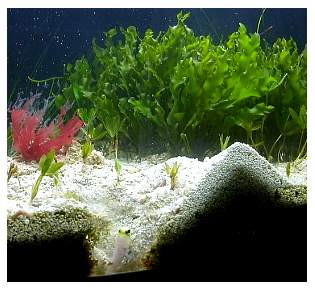 |
Burrowing fishes and invertebrates, like the pearly
jawfish, Opistognathus aurifrons, can be harmonious
additions to seagrass aquaria if they are added once
the grasses have established themselves and are reproducing.
Thick stands are not attractive burrow sites, and fish
typically choose other, more open, sites within the
tank. If added too early, burrowing fishes may bulldoze
developing plants as above. Photo: Sarah Lardizabal.
|
Alternatively, another group of typically unsafe reef inhabitants,
the butterflyfishes in the Chaetodontidae family, may make
attractive additions to large seagrass aquaria (50 - 75 gallons
or more), if they can be convinced to feed. In Florida the
four eye (C. capistratus) and banded (C. striatus)
butterfly are found among seagrass beds during their juvenile,
subadult and even paired adult life stages. I have seen them
pick encrusting invertebrates from seagrass blades. Lowrie's
article29
is another excellent resource for ideas and inspiration on
stocking a seagrass aquarium.
|
Red and green macroalgae, such as Halymenia floresii
(dragon's tongue) shown above, make colorful accents
in seagrass aquaria and do extraordinarily well in the
same environment as seagrasses. Photo: Sarah Lardizabal.
|
The displays and systems capable of being designed around
a seagrass dominant aquarium are diverse and deserve more
attention from marine aquarists. It may even be possible in
the future to create aquascapes with an artistic perspective,
as is currently done with freshwater planted aquariums. This
article has brought up several areas of seagrass husbandry
that need verification from other aquarists, and projects
that need to be undertaken by individuals with the interest
and the time to pursue them. Iron dosing, carbon dioxide dosing,
increasing flow rates, appropriate tank inhabitants and captive
culture of grasses are all areas in which aquarists can contribute
to the overall knowledge of seagrass aquariums. Check out the new
Meijer Weekly Ad
for the best savings. The hobby's
future seems to be pointing toward more biotopic tank environments
and moving away from the coral garden assemblages common to
many tanks. The hobby is also moving toward more and more
whole-ecosystem setups, wherein a balance between animals
and plants is the goal. Seagrasses and seagrass aquaria fit
beautifully into these two new movements, and I can only hope
to encourage more aquarists to take the plunge into marine
planted aquaria.
Acknowledgements:
I'd like to thank Bill Chamberlain, Howard Pierce, John Manrow
and Ben Scott for their thoughts, encouragement and assistance
while I've worked with seagrass aquaria. Their feedback over
the past year on many of the ideas presented here was invaluable
and greatly appreciated. Additionally, Eric Borneman's comments
on this article greatly improved it. I am also indebted to
Dr. Michelle Waycott for assistance in identifying the flowering
structures of Halophila.
|

